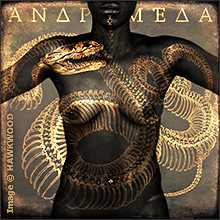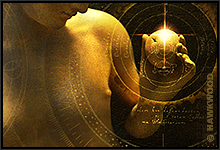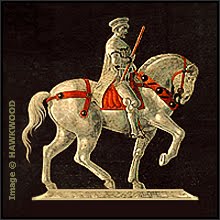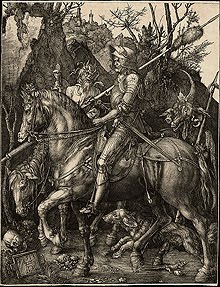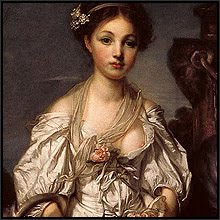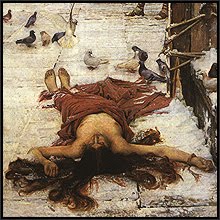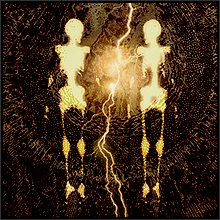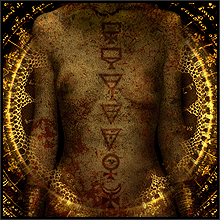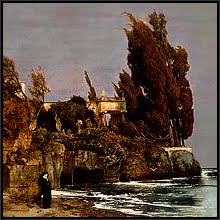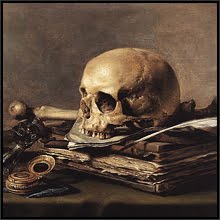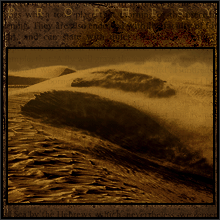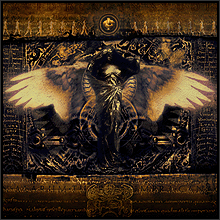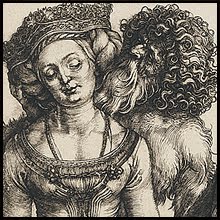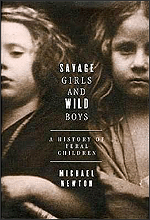Two robed men engaged in conversation are about to descend a wide flight of steps, to the sides of which friezes of winged angels swirl and flow around the pillars that the men are about to pass between. Both the men and the steps are bathed in bright sunlight, and the scene seems at first idyllic. But behind the two figures rises an impenetrable wall of tall Lombardy poplars, their shadows so dense that it seems almost as if we are staring into the darkness of space. The work's title confirms the foreboding. This is Steps to the Tomb (below), by the American illustrator Franklin Booth.
 Like his fellow-countryman Maxfield Parrish, who also was active in the 1920's, Booth strove to create worlds redolent with the romance of a sunlit age that never was. But something in Booth’s makeup kept pulling him towards darker regions; his compositions so often feature tombs, burials, dark interiors, walls of shadows too dark to penetrate. To what extent Booth himself was aware of this hankering after the darkness is unclear; what is certain is that his body of work, executed almost entirely in chiselled pen strokes and black ink, is masterful in the range of tones and textures which he created with his limited choice of medium.
Like his fellow-countryman Maxfield Parrish, who also was active in the 1920's, Booth strove to create worlds redolent with the romance of a sunlit age that never was. But something in Booth’s makeup kept pulling him towards darker regions; his compositions so often feature tombs, burials, dark interiors, walls of shadows too dark to penetrate. To what extent Booth himself was aware of this hankering after the darkness is unclear; what is certain is that his body of work, executed almost entirely in chiselled pen strokes and black ink, is masterful in the range of tones and textures which he created with his limited choice of medium.
 Even in small details of his work (the footer of a decorative border, above), there is a reaching out, a gesture of longing, that we feel will go unrequited. Who are these beseeching robed figures? We do not know, and the artist does not tell us. At times Booth's subject matter is more direct, as in Burial (below). Here the composition is - quite literally - half in shadow, half in light. To the right: towering sunlit spires and a congregation of figures emerging from a walled garden. To the left: darkness and shadow, as a priest reads the burial service while mourners contemplate a casket and the mysteries of mortality. Ashes to ashes, and dust to dust, reads the tomb's inscription.
Even in small details of his work (the footer of a decorative border, above), there is a reaching out, a gesture of longing, that we feel will go unrequited. Who are these beseeching robed figures? We do not know, and the artist does not tell us. At times Booth's subject matter is more direct, as in Burial (below). Here the composition is - quite literally - half in shadow, half in light. To the right: towering sunlit spires and a congregation of figures emerging from a walled garden. To the left: darkness and shadow, as a priest reads the burial service while mourners contemplate a casket and the mysteries of mortality. Ashes to ashes, and dust to dust, reads the tomb's inscription.
 With The End of the Way (below), we have crossed the threshold. Booth actually takes us beyond death to the realm that awaits. The robed soul, airily floating on tiptoe, is received by a bearded angel to be guided further. In the background, figures on the path are still approaching, dwarfed under towering piled cumulus.
With The End of the Way (below), we have crossed the threshold. Booth actually takes us beyond death to the realm that awaits. The robed soul, airily floating on tiptoe, is received by a bearded angel to be guided further. In the background, figures on the path are still approaching, dwarfed under towering piled cumulus.
 In The Healed Ones (below), the artist carries us even further into the beyond. Souls drift through the airy spaces as light as the clouds behind them. In the foreground, the 'healed ones' of the work's title are welcomed by other heavenly guides. Booth's masterful pen style is here very apparent. The face and arms of the central female figure are described entirely with varying thicknesses of continuous pen lines.
In The Healed Ones (below), the artist carries us even further into the beyond. Souls drift through the airy spaces as light as the clouds behind them. In the foreground, the 'healed ones' of the work's title are welcomed by other heavenly guides. Booth's masterful pen style is here very apparent. The face and arms of the central female figure are described entirely with varying thicknesses of continuous pen lines.
 This device of the artist's of setting foreground figures against distant backgrounds is abandoned in The House of Rimmon (below). Here the groups of figures are distant and anonymous, as we are led through layers of foreground shadows into sunlight and then back into far shadows again. Booth's chiselled linework seems here almost to make the shadows come alive and drift like smoke up to the building's vast roof. It could be the stage set of an opera.
This device of the artist's of setting foreground figures against distant backgrounds is abandoned in The House of Rimmon (below). Here the groups of figures are distant and anonymous, as we are led through layers of foreground shadows into sunlight and then back into far shadows again. Booth's chiselled linework seems here almost to make the shadows come alive and drift like smoke up to the building's vast roof. It could be the stage set of an opera.
 Franklin Booth was in one sense a jobbing illustrator. He made his living producing line drawings to illustrate articles for the magazines and periodicals of his day - Good Housekeeping, Scribner's Magazine, and others. Sometimes his work was produced for individual books, as with his vignette for The Flying Islands of the Night (below), by James Riley.
Franklin Booth was in one sense a jobbing illustrator. He made his living producing line drawings to illustrate articles for the magazines and periodicals of his day - Good Housekeeping, Scribner's Magazine, and others. Sometimes his work was produced for individual books, as with his vignette for The Flying Islands of the Night (below), by James Riley.
 What sets Booth's work apart is his truly masterly pen technique, with which he described forms and textures, light and shadows - and even a suggested effect of colour - through his pen alone. And there is a darkness there which is the darkness that leads to the tomb. But the artist also carries us beyond these shadowy places to show us other realms. Death, Booth seems to wish to reassure us, is not the end of the way.
What sets Booth's work apart is his truly masterly pen technique, with which he described forms and textures, light and shadows - and even a suggested effect of colour - through his pen alone. And there is a darkness there which is the darkness that leads to the tomb. But the artist also carries us beyond these shadowy places to show us other realms. Death, Booth seems to wish to reassure us, is not the end of the way.

 Like his fellow-countryman Maxfield Parrish, who also was active in the 1920's, Booth strove to create worlds redolent with the romance of a sunlit age that never was. But something in Booth’s makeup kept pulling him towards darker regions; his compositions so often feature tombs, burials, dark interiors, walls of shadows too dark to penetrate. To what extent Booth himself was aware of this hankering after the darkness is unclear; what is certain is that his body of work, executed almost entirely in chiselled pen strokes and black ink, is masterful in the range of tones and textures which he created with his limited choice of medium.
Like his fellow-countryman Maxfield Parrish, who also was active in the 1920's, Booth strove to create worlds redolent with the romance of a sunlit age that never was. But something in Booth’s makeup kept pulling him towards darker regions; his compositions so often feature tombs, burials, dark interiors, walls of shadows too dark to penetrate. To what extent Booth himself was aware of this hankering after the darkness is unclear; what is certain is that his body of work, executed almost entirely in chiselled pen strokes and black ink, is masterful in the range of tones and textures which he created with his limited choice of medium. Even in small details of his work (the footer of a decorative border, above), there is a reaching out, a gesture of longing, that we feel will go unrequited. Who are these beseeching robed figures? We do not know, and the artist does not tell us. At times Booth's subject matter is more direct, as in Burial (below). Here the composition is - quite literally - half in shadow, half in light. To the right: towering sunlit spires and a congregation of figures emerging from a walled garden. To the left: darkness and shadow, as a priest reads the burial service while mourners contemplate a casket and the mysteries of mortality. Ashes to ashes, and dust to dust, reads the tomb's inscription.
Even in small details of his work (the footer of a decorative border, above), there is a reaching out, a gesture of longing, that we feel will go unrequited. Who are these beseeching robed figures? We do not know, and the artist does not tell us. At times Booth's subject matter is more direct, as in Burial (below). Here the composition is - quite literally - half in shadow, half in light. To the right: towering sunlit spires and a congregation of figures emerging from a walled garden. To the left: darkness and shadow, as a priest reads the burial service while mourners contemplate a casket and the mysteries of mortality. Ashes to ashes, and dust to dust, reads the tomb's inscription. With The End of the Way (below), we have crossed the threshold. Booth actually takes us beyond death to the realm that awaits. The robed soul, airily floating on tiptoe, is received by a bearded angel to be guided further. In the background, figures on the path are still approaching, dwarfed under towering piled cumulus.
With The End of the Way (below), we have crossed the threshold. Booth actually takes us beyond death to the realm that awaits. The robed soul, airily floating on tiptoe, is received by a bearded angel to be guided further. In the background, figures on the path are still approaching, dwarfed under towering piled cumulus. In The Healed Ones (below), the artist carries us even further into the beyond. Souls drift through the airy spaces as light as the clouds behind them. In the foreground, the 'healed ones' of the work's title are welcomed by other heavenly guides. Booth's masterful pen style is here very apparent. The face and arms of the central female figure are described entirely with varying thicknesses of continuous pen lines.
In The Healed Ones (below), the artist carries us even further into the beyond. Souls drift through the airy spaces as light as the clouds behind them. In the foreground, the 'healed ones' of the work's title are welcomed by other heavenly guides. Booth's masterful pen style is here very apparent. The face and arms of the central female figure are described entirely with varying thicknesses of continuous pen lines. This device of the artist's of setting foreground figures against distant backgrounds is abandoned in The House of Rimmon (below). Here the groups of figures are distant and anonymous, as we are led through layers of foreground shadows into sunlight and then back into far shadows again. Booth's chiselled linework seems here almost to make the shadows come alive and drift like smoke up to the building's vast roof. It could be the stage set of an opera.
This device of the artist's of setting foreground figures against distant backgrounds is abandoned in The House of Rimmon (below). Here the groups of figures are distant and anonymous, as we are led through layers of foreground shadows into sunlight and then back into far shadows again. Booth's chiselled linework seems here almost to make the shadows come alive and drift like smoke up to the building's vast roof. It could be the stage set of an opera. Franklin Booth was in one sense a jobbing illustrator. He made his living producing line drawings to illustrate articles for the magazines and periodicals of his day - Good Housekeeping, Scribner's Magazine, and others. Sometimes his work was produced for individual books, as with his vignette for The Flying Islands of the Night (below), by James Riley.
Franklin Booth was in one sense a jobbing illustrator. He made his living producing line drawings to illustrate articles for the magazines and periodicals of his day - Good Housekeeping, Scribner's Magazine, and others. Sometimes his work was produced for individual books, as with his vignette for The Flying Islands of the Night (below), by James Riley. What sets Booth's work apart is his truly masterly pen technique, with which he described forms and textures, light and shadows - and even a suggested effect of colour - through his pen alone. And there is a darkness there which is the darkness that leads to the tomb. But the artist also carries us beyond these shadowy places to show us other realms. Death, Booth seems to wish to reassure us, is not the end of the way.
What sets Booth's work apart is his truly masterly pen technique, with which he described forms and textures, light and shadows - and even a suggested effect of colour - through his pen alone. And there is a darkness there which is the darkness that leads to the tomb. But the artist also carries us beyond these shadowy places to show us other realms. Death, Booth seems to wish to reassure us, is not the end of the way.
PLEASE NOTE: The images for this post were made from scans taken from the book The Art of Franklin Booth, which is itself a 1976 facsimile reprint edition of a tribute to Booth published originally in 1925. This much-treasured book has been on my bookshelf for the last thirty-odd years, but I learned only recently from the Internet that this facsimile apparently is even more scarce than the original, with only thirteen known copies catalogued! So as I now realize, I own the fourteenth, and this post therefore reflects a homage to Booth’s art more rare than I myself was aware of at the time that I compiled it.



